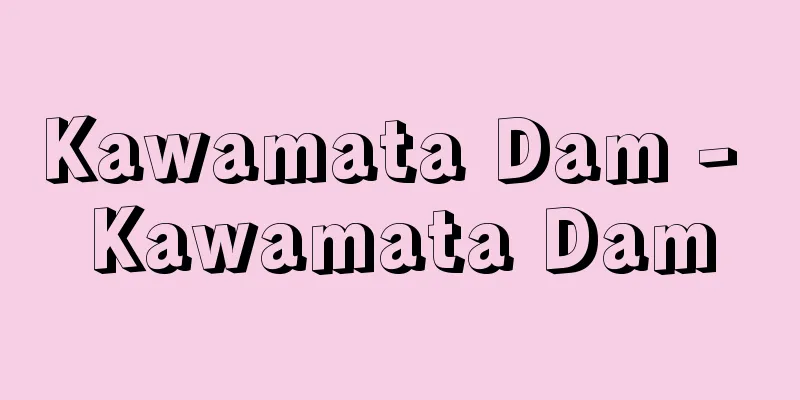Kokufu (English spelling) national wealth

|
Roughly speaking, national wealth is the accumulated result of the activities of the people of a country. In the past, national wealth was considered to be the total assets of the people of a country, including land and natural resources, and was vaguely considered to measure the rise and fall of national power. However, in recent years, since the establishment of the reproduction theory and the theory of national accounts, it has been clearly defined as the total amount of all reproducible tangible assets owned by the residents of a country at a certain point in time, evaluated in monetary value at a specific point in time. Furthermore, in the 1968 United Nations New System of National Accounts (New SNA), in addition to the above perspective, the scope was expanded to include non-reproducible assets and intangible assets, with the aim of simultaneously grasping the asset base of a country. To clarify the distinction, it is appropriate to call the latter national wealth in a broad sense as necessary. [Kenichi Miyazawa] Stocks and flows The reason for conceptualizing national wealth in this way is that it is the capital that produces national income, which is the annual flow of goods and services that is the result of the activities of the national economy, and at the same time, it is also the stock of various goods that is accumulated as a result of that. The quantitative relationship between national wealth and national income is as follows: The assets that make up national wealth are of diverse types and have a wide variety of owners and users, so it is a considerable challenge to evaluate these diverse assets in a unified and objective manner. In Japan, detailed valuation methods are provided as the basis for the figures in the Annual Report on National Accounts published annually by the Cabinet Office (formerly the Economic Planning Agency). [Kenichi Miyazawa] The Two Faces of National WealthNational wealth has two faces, and both sides should be the same size. One is to look at national wealth from the physical side, which is broken down into the following: first, as reproducible tangible assets, there are fixed assets (buildings, machinery, ships, vehicles, tools, equipment, etc.), and inventory or stock (raw materials, work in progress, finished products, stored goods). Next, as non-reproducible tangible assets, there are land, underground resources, and fishing grounds (other assets include rivers, lakes, and beaches, but these are generally not traded and are difficult to value, so they are excluded), and as intangible non-financial assets, there are patent rights, trademark rights, copyrights, etc. (Goodwill in corporate accounting is not included). As mentioned above, the total national wealth is calculated by adding the net external assets to the above. However, due to the constraints of estimation, intangible non-financial assets and historical monuments (historic sites, buildings) are not included as official figures, but are shown in the margins as reference figures, which is the current method in Japan. The other face of national wealth is seen from the perspective of claims. Each economic entity that is a member of the national economy holds assets and incurs liabilities, and the net amount obtained by subtracting the total liabilities from the total assets held by each entity is the net assets of each entity. This constitutes each entity's claim to ultimate ownership. And the total amount of claims, calculated by adding up the net assets of all economic entities, is equal to the total assets of the real aspect of the national economy. National wealth thus has two aspects: a real aspect and a claims aspect. [Kenichi Miyazawa] National wealth and financial assets and liabilitiesWhat mediates these two aspects of national wealth? What connects the two sides is the relationship of borrowing and lending, and the balance of financial assets and liabilities. Individual entities within a country relate to each other through financial borrowing and lending. However, when viewed as a whole national economy, a loan from one side is always a borrowing from the other. Therefore, in the economy as a whole, the balances of the two sides match, and if the national economy is integrated into a single entity, the financial asset and liability balances cancel each other out, positive and negative. And what remains in the overall asset and liability balance, which includes both the real and financial sides, is only real assets on the real side, and only net assets on the rights side. In this way, these two sides correspond to each other just like the front and back of a medal. This double-sided connection seen in national wealth reflects the dual nature of assets themselves. The first aspect is that of a stock of real assets used in production and consumption activities, and the second aspect is that of ownership rights, that is, who has the ultimate claim to existing real assets. Thus, in order to understand the relationship between these two aspects, national wealth statistics alone are insufficient; they must also be linked with statistics on financial assets and liabilities. A statistical table that includes both of these is the account table of the national economy, known as the national balance sheet. [Kenichi Miyazawa] "Japan's Economic Circulation" by Kenichi Miyazawa, 4th edition (1980, Shunjusha)" ▽ "Japan's National Wealth Statistics" (1976), compiled and published by the Economic Planning Agency's Economic Research Institute" ▽ "Annual Report on National Accounts" compiled by the Economic Planning Agency, various editions (Published by the Cabinet Office and Medialand, starting with the 2001 edition published in April 2001 by the Printing Bureau of the Ministry of Finance)" [References] | | | | | | |Source: Shogakukan Encyclopedia Nipponica About Encyclopedia Nipponica Information | Legend |
|
国富とは、ごく大づかみには、一国の国民活動の結果としての蓄積された成果をいう。かつては、国富は一国の住民の財産の集計であるとされ、土地や天然資源なども含められて、漠然と国力の消長を測るものとされたこともある。しかし近年、再生産論的な見方や国民経済計算論が確立されてから明確に規定され、ある国の居住者によって所有される再生産可能ないっさいの有形財の、一定時点における合計額を、特定時点の貨幣価値で評価したもの、と定義されるようになった。さらに1968年の国際連合の新しい国民経済計算方式(新SNA)では、以上の見方に加えて、一国の財産基礎をも同時に把握する目的から、範囲を広げて、再生産不可能資産や無形資産を含める概念に移行した。区別を明確にするには、後者を、必要に応じ広義の国富と呼び分けるのが適切である。 [宮澤健一] ストックとフロー国富をこういう形で概念する意味は、それが国民経済の活動の成果としての年々の財貨・サービスの流れ(フロー)たる国民所得を生み出す元本であると同時に、またそれが、その結果としての蓄積された諸財の蓄え(ストック)でもあるからである。国富と国民所得の両者の数量上の関係は、 国富を構成する諸資産は、その種類も多様で、所有者、使用者もさまざまであるから、これら多様な資産を統一的、客観的にどう評価するかは、かなりの難事業である。日本の場合、内閣府(旧経済企画庁)から毎年公刊される『国民経済計算年報』の計数の基礎として、評価方法の細かい約束が用意されている。 [宮澤健一] 国富の二面国富には二つの顔があって、そのいずれの側からみても同じ大きさとなっているはずである。一つは、国富を実物面からみることで、その内訳は、まず再生産可能有形資産として、固定資産(建物、機械、船舶、車両、器具、備品など)、棚卸資産ないし在庫(原材料、仕掛け品、完成品、貯蔵品)がある。次に、再生産不可能有形資産として、土地、地下資源、漁場(ほかに河川、湖沼、海浜地などもあるが、これらはおおむね取引されることもなく評価も困難なため除外される)、また無形非金融資産として、特許権、商標権、著作権などが含められる(企業会計上の「のれん」は対象外)。既述のように、以上のものに対外純資産が加えられて国富総額が得られる。ただし推計上の制約から、上記中の無形非金融資産や歴史的記念物(史跡、建造物)などは正式数値としてでなく、推計体系から外して参考数値として欄外に示すのが、日本の現行方式である。 国富のもう一つの顔は、請求権という権利面から眺めることである。国民経済の構成員であるおのおのの経済主体は資産を保有するとともに負債を負っているが、各主体が保有する総資産から総負債を差し引いた純額が、それぞれの主体の正味資産である。これが各主体の究極的な所有への請求権を構成する。そして、すべての経済主体にわたってその正味資産を合計した請求権の総額は、他方における国民経済の実物面の資産総額と一致する。国富はこうして、実物的側面と請求権的側面との二面をもっているのである。 [宮澤健一] 国富と金融資産負債国富のこの二側面は何によって媒介されているのか。両面をつないでいるものは貸借関係であり、金融資産負債の残高関係である。一国内の個々の主体は金融的な貸し借りによって関係しあっている。ところが、国民経済全体としてみれば、一方の貸しはかならず他方の借りである。したがって、経済全体では両者の残高は一致して、国民経済を一本に統合すれば、金融資産負債残高はプラス・マイナス相互に相殺される。そして、実物面、金融面の双方を含む全体の資産負債バランスにおいて相殺されずに残るのは、実物面では実物資産のみであり、権利面では正味資産のみである。こうしてこの両面は、ちょうどメダルの表と裏のように相互に対応しあう。 このような国富にみられる両面の結び付きは、資産というものそれ自体がもつ二面的性質の反映である。その第一の性質は、生産や消費の活動のために用いられる実物資産ストックとしての側面であり、その第二の性質は、現存する実物資産に対する究極的な請求権がだれに帰属するかという、所有の権利の側面である。かくて、この両面のつながり関係を知るためには、国富統計だけでは不十分で、金融資産負債の統計と連結されなくてはならない。この両者を含んだ統計表が、国民貸借対照表とよばれる国民経済の勘定表である。 [宮澤健一] 『宮澤健一著『日本の経済循環』第4版(1980・春秋社)』▽『経済企画庁経済研究所編・刊『日本の国富統計』(1976)』▽『経済企画庁編『国民経済計算年報』各年版(大蔵省印刷局、2001年4月発行の平成13年度版より内閣府編、メディアランド発行)』 [参照項目] | | | | | | |出典 小学館 日本大百科全書(ニッポニカ)日本大百科全書(ニッポニカ)について 情報 | 凡例 |
>>: National government office
Recommend
Mishima [city] - Mishima
A city in eastern Shizuoka Prefecture. It was inco...
Monstrum
…It is also used to mean a deformed body. In anci...
Yun Bong-gil
1909-1932 Korean independence activist. Born in t...
Etatisme - Etatisme
Please see the "Nationalism" page. Sour...
Color painting - Iroe
It is also called Akae, Nishikide, and Gosai. It ...
Edgeworth's Box Diagram
…Then, the Pareto optimal resource allocation can...
ureide
…(2) Urea (H 2 N) 2 CO is a general term for a co...
Japan Socialist League
A socialist unity organization in the early 1920s....
Heritage Attribution War - Issankizoku Senso
...war in which France invaded the southern Nethe...
《Kirare Otomi》 - Kirare Otomi
...3 acts, 9 scenes. Commonly known as "Kira...
koinon
…The most important and exceptionally long-lastin...
Taishet (English spelling)
A city in Irkutsk Oblast, in the south of Eastern ...
Takeshi Kaiko
Born: December 30, 1930, Osaka [Died] December 9, ...
Willi Bredel
German novelist. Born in Hamburg as the son of a ...
"Omi Genji (■1) Lecture" - Omi Genji Shikata Koshaku
...Of these, "Nanban Tetsu Goto Menuki"...





![Iwachi [Hot Springs] - Iwachi](/upload/images/67cf761aa5b24.webp)



